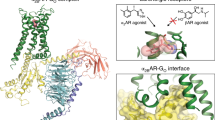Abstract
DIHYDROERGOCRYPTINE is a potent antagonist of α-adrenoreceptors1 that has recently been labelled to high specific radioactivity with tritium2. 3H-DHEC was found to bind to a crude membrane preparation of rabbit uterus, and a portion of this binding was suppressible by phentolamine2. The saturability, reversibility and structural and steric selectivity of this specific binding component suggested that it represents α-adrenoreceptors mediating uterine contractions2–4. In subsequent studies, 3H-DHEC was used to tentatively identify α-adrenoreceptors mediating various biological responses in several tissues5–10. The evidence for the identity of 3H-DHEC binding sites in tissue fragments with functional α-receptors in intact tissues is indirect, and is based on the demonstration of similar potencies of various ligands in suppressing 3H-DHEC binding and producing or inhibiting physiological responses. The absolute potency of particular ligands to suppress binding or affect the physiological response, often differs markedly. However, this could be due to changes in the properties of receptors caused by tissue disruption, or the different conditions in which potencies are determined. Therefore, the validity of the use of 3H-DHEC or other reversible ligands to label functionally relevant receptors must be tested in experiments where the above complications can be reduced or eliminated. We report here the use of an irreversible α-adrenoreceptor antagonist which provided a way to bridge the gap between physiological experiments measuring mechanical responses of an intact tissue and binding assays using membrane fragments, α-Receptors mediating contractions of isolated rabbit uterine strips were irreversibly blocked by phenoxybenzamine (POB), and 3H-DHEC binding was then measured in membranes prepared from these POB-treated and from untreated control strips. The results obtained dissociate phentolamine-suppressible 3H-DHEC binding and α-receptors mediating uterine contraction, but indicate that a fraction of the binding with low capacity and high affinity for DHEC, may represent true postsynaptic α-receptors.
This is a preview of subscription content, access via your institution
Access options
Subscribe to this journal
Receive 51 print issues and online access
$199.00 per year
only $3.90 per issue
Buy this article
- Purchase on Springer Link
- Instant access to full article PDF
Prices may be subject to local taxes which are calculated during checkout
Similar content being viewed by others
References
Rothlin, E. Bull. schweiz. Akad. med. Wiss. 2, 249–273 (1947).
Williams, L. T. & Lefkowitz, R. J. Science 192, 791–793 (1976).
Williams, L. T., Mullikin, D. & Lefkowitz, R. J. J. biol. Chem. 251, 6915–6923 (1976).
Williams, L. T. & Lefkowitz, R. J. Molec. Pharmac. 13, 304–313 (1977).
Tsai, B. S. & Lefkowitz, R. J. J. Pharmac. exp. Ther. 204, 606–614 (1978).
Strittmatter, W. J., Davis, J. N. & Lefkowitz, R. J. J. biol. Chem. 252, 5472–5477 (1977).
Guallaen, G., Yates-Aggerbeck, M., Vauquelin, G., Strosberg, D. & Hanoune, J. J. biol. Chem, 253, 1114–1120 (1978).
Kafka, M. S., Tallman, J. R., Smith, C. C. & Costa, J. L. Life Sci. 21, 1429–1438 (1977).
Greenberg, D. A., U'Prichard, D. C., Sheehan, P. & Snyder, S. H. Brain Res., 140, 378–384 (1978).
Sharma, V. K. & Banerjee, S. P. J. biol. Chem. 253, 5277–5279 (1978).
Lewis, J. E. & Miller, J. W. J. Pharmac. exp. Ther. 154, 46–55 (1966).
Dubocovich, M. & Langer, S. Z. J. Physiol., Lond. 237, 505–519 (1974).
Kalsner, S. & Nickerson, M. Br. J. Pharmac. 35, 428–439 (1969).
Yong, M. S. & Nickerson, M. J. Pharmacl. exp. Ther. 186, 100–108 (1973).
Roberts, J. M., Insel, P. A., Goldfien, R. D. & Goldfien, A. Nature 270, 624–625 (1977).
Author information
Authors and Affiliations
Rights and permissions
About this article
Cite this article
KUNOS, G., HOFFMAN, B., KWOK, Y. et al. Dihydroergocryptine binding and α-adrenoreceptors in smooth muscle. Nature 278, 254–256 (1979). https://doi.org/10.1038/278254a0
Received:
Accepted:
Issue Date:
DOI: https://doi.org/10.1038/278254a0
This article is cited by
-
Dihydroergocryptine binding and α-adrenoreceptors in smooth muscle
Nature (1980)
-
Dihydroergocryptine binding and α-adrenoreceptors in smooth muscle (reply)
Nature (1980)
-
Dihydroergocryptine binding and α-adrenoreceptors in smooth muscle
Nature (1980)
-
Dihydroergocryptine is a non-selective antagonist for human platelet α-adrenoreceptors
Nature (1979)
Comments
By submitting a comment you agree to abide by our Terms and Community Guidelines. If you find something abusive or that does not comply with our terms or guidelines please flag it as inappropriate.



